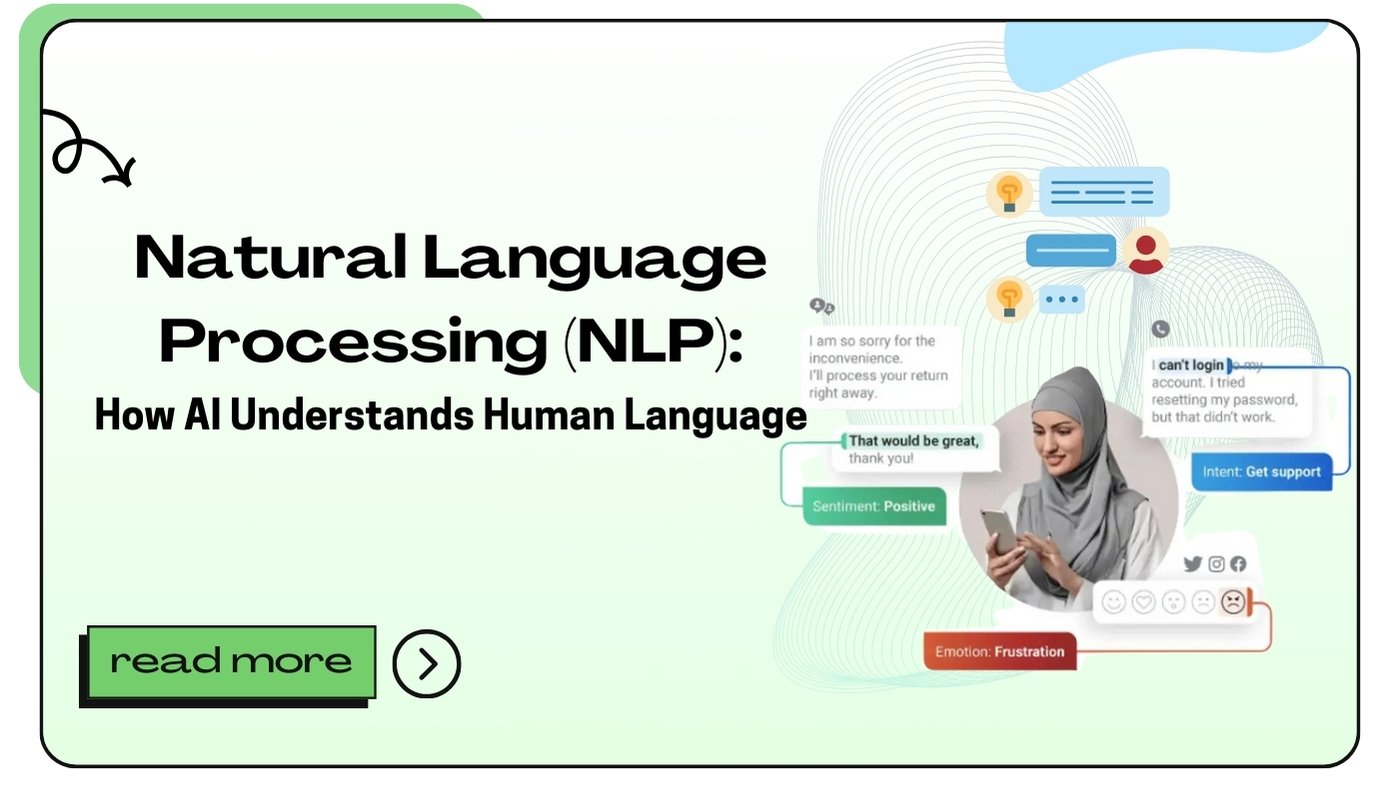Natural Language Processing (NLP) is a subfield of artificial intelligence (AI) focused on enabling machines to understand, interpret, and respond to human language. The intersection of computer science, linguistics, and AI, NLP is critical for various applications, from virtual assistants to sentiment analysis. In this comprehensive guide, we will explore how NLP works, its key techniques, applications, and future trends, ensuring that you grasp the essentials of this fascinating technology.
The Importance of Natural Language Processing
NLP plays a crucial role in bridging the gap between humans and machines. As our world becomes increasingly digital, the ability for computers to understand and interact using natural language has never been more vital. With NLP, businesses can automate customer service, analyze social media sentiment, and enhance user experiences, among many other applications.
Why NLP Matters in Today’s World
- Increased Data Volume: The rise of digital communication has led to vast amounts of unstructured data. NLP helps organizations make sense of this data by extracting meaningful insights.
- Enhanced User Interactions: Virtual assistants like Siri, Alexa, and Google Assistant rely on NLP to interact with users in a conversational manner, making technology more accessible.
- Business Efficiency: By automating tasks like sentiment analysis and customer support, NLP can significantly reduce operational costs and improve efficiency.
How Natural Language Processing Works
Understanding how NLP works requires a grasp of its core components and techniques. At its heart, NLP combines linguistics and computer science to process and analyze human language data.
Core Components of NLP
- Tokenization: This process involves breaking text into smaller units, such as words or phrases, which are called tokens. For example, the sentence “AI is transforming industries” would be tokenized into [“AI”, “is”, “transforming”, “industries”].
- Part-of-Speech Tagging: After tokenization, each token is assigned a part-of-speech tag (noun, verb, adjective, etc.). This step helps the NLP system understand the grammatical structure of the text.
- Named Entity Recognition (NER): NER identifies and classifies entities in the text, such as names, dates, locations, and organizations. For instance, in the sentence “Apple is releasing a new product,” “Apple” would be tagged as an organization.
- Parsing: Parsing involves analyzing the syntactic structure of sentences. It helps in understanding the relationship between different tokens and their grammatical roles.
- Sentiment Analysis: This technique determines the sentiment expressed in a piece of text, categorizing it as positive, negative, or neutral. Sentiment analysis is widely used in customer feedback analysis and social media monitoring.
Techniques in Natural Language Processing
Several techniques underpin NLP, each serving distinct purposes in processing human language. Here are some of the most important techniques:
1. Machine Learning in NLP
Machine learning algorithms are integral to modern NLP applications. By training models on large datasets, these algorithms learn to recognize patterns in language, allowing them to make predictions or classifications based on new input.
- Supervised Learning: In this approach, models are trained on labeled data, meaning each training example is paired with the correct output. For instance, a sentiment analysis model might be trained on a dataset of customer reviews labeled as positive or negative.
- Unsupervised Learning: Unlike supervised learning, unsupervised learning involves training models on unlabelled data. This technique is often used for tasks like clustering similar texts together.
2. Deep Learning and NLP
Deep learning, a subset of machine learning, has revolutionized NLP by enabling the creation of more complex models capable of understanding nuanced language patterns. Techniques such as recurrent neural networks (RNNs) and transformers have become popular in recent years.
- Recurrent Neural Networks (RNNs): RNNs are designed to handle sequential data, making them suitable for language processing. They can maintain a memory of previous inputs, which is crucial for understanding context.
- Transformers: Introduced in the paper “Attention is All You Need,” transformers have set new benchmarks in NLP tasks. They use a mechanism called attention to weigh the importance of different words in a sentence, allowing for better contextual understanding.
Applications of Natural Language Processing
NLP has a wide range of applications across various industries, enabling organizations to harness the power of human language in innovative ways. Here are some notable applications:
1. Chatbots and Virtual Assistants
One of the most visible applications of NLP is in chatbots and virtual assistants. These AI-driven systems use NLP to understand user queries and respond appropriately, making them valuable for customer support and engagement.
- Customer Service Automation: Businesses use chatbots to handle common customer inquiries, reducing wait times and freeing human agents for more complex tasks.
- Personalized Experiences: Virtual assistants like Google Assistant and Amazon Alexa utilize NLP to provide personalized recommendations based on user preferences.
2. Sentiment Analysis
NLP enables organizations to perform sentiment analysis on social media, customer reviews, and other text data. By understanding public sentiment, businesses can make informed decisions about marketing strategies, product development, and brand management.
- Market Research: Companies can gauge consumer reactions to new products or campaigns by analyzing sentiment data from social media.
- Reputation Management: Monitoring sentiment around a brand can help organizations address negative feedback and improve their public image.
3. Language Translation
NLP plays a crucial role in machine translation, allowing users to translate text from one language to another. Services like Google Translate rely on NLP techniques to provide accurate translations.
- Real-Time Translation: With advances in NLP, real-time translation services are becoming increasingly common, facilitating seamless communication between speakers of different languages.
- Multilingual Content Creation: Businesses can expand their reach by automatically translating content for different markets, enhancing accessibility.
Challenges in Natural Language Processing
Despite its advancements, NLP faces several challenges that researchers and developers must address to improve its effectiveness.
1. Ambiguity in Language
Natural language is often ambiguous, with words and phrases having multiple meanings. For example, the word “bank” can refer to a financial institution or the side of a river. NLP systems must develop context-aware mechanisms to disambiguate such terms.
- Contextual Understanding: Algorithms need to consider the surrounding words and overall context to determine the intended meaning accurately.
2. Sarcasm and Irony
Detecting sarcasm and irony poses a significant challenge for NLP systems. A statement like “Great job!” can be sincere or sarcastic depending on the context. Understanding these subtleties requires a deep comprehension of human language.
- Training on Diverse Data: To improve sarcasm detection, NLP models should be trained on diverse datasets that include examples of sarcastic language.
3. Cultural Nuances
Language varies across cultures, with different phrases and expressions conveying distinct meanings. NLP systems must account for these cultural differences to avoid misinterpretation.
- Cultural Sensitivity: Ensuring that NLP models are culturally sensitive and inclusive is crucial for their success in global applications.
Future Trends in Natural Language Processing
The field of NLP is constantly evolving, driven by technological advancements and changing user needs. Here are some emerging trends to watch for in the future:
1. Conversational AI
The demand for conversational AI solutions is on the rise, with businesses looking to create more engaging and human-like interactions. Future NLP developments will focus on enhancing the naturalness of conversations.
- Emotion Recognition: Future systems may incorporate emotion recognition to tailor responses based on the user’s emotional state, leading to more empathetic interactions.
- Contextual Awareness: Advanced conversational AI will better understand context, allowing for more meaningful and relevant responses.
2. Multimodal NLP
Multimodal NLP aims to integrate various forms of data, such as text, audio, and images, to enhance understanding. This approach enables AI systems to process information more like humans do.
- Enhanced User Experiences: By combining text with visual and auditory data, multimodal NLP can provide richer user experiences in applications like virtual reality and augmented reality.
3. Ethical Considerations in NLP
As NLP continues to evolve, ethical considerations will play a more prominent role. Issues like bias in language models and the implications of AI-generated content will need to be addressed.
- Fairness and Transparency: Researchers will work towards developing NLP models that are fair and transparent, ensuring that AI systems do not perpetuate harmful biases.
Conclusion
Natural Language Processing is a transformative technology that enables machines to understand and interact with human language. From chatbots to sentiment analysis, the applications of NLP are vast and continue to grow. As the field evolves, it will overcome challenges such as ambiguity, sarcasm detection, and cultural nuances. With ongoing advancements in machine learning, deep learning, and ethical considerations, the future of NLP holds great promise for enhancing human-computer interactions and driving innovation across industries.
20 Unique FAQs About Natural Language Processing (NLP)
- What is Natural Language Processing (NLP)?
NLP is a branch of artificial intelligence that focuses on enabling machines to understand and interpret human language. - How does NLP work?
NLP works by utilizing algorithms and techniques to analyze, tokenize, and process language data, allowing machines to understand context and meaning. - What are some common applications of NLP?
Common applications include chatbots, sentiment analysis, language translation, and content recommendation systems. - What is tokenization in NLP?
Tokenization is the process of breaking down text into smaller units called tokens, such as words or phrases. - How does sentiment analysis function?
Sentiment analysis determines the sentiment expressed in text, categorizing it as positive, negative, or neutral, often using machine learning models. - What role do neural networks play in NLP?
Neural networks, particularly deep learning models like RNNs and transformers, are used to process and analyze language data for better contextual understanding. - What is named entity recognition (NER)?
NER is a technique that identifies and classifies entities in text, such as names, dates, and locations. - How does machine translation work?
Machine translation uses NLP techniques to automatically translate text from one language to another, considering context and grammar. - What are the challenges faced by NLP?
Challenges include ambiguity in language, sarcasm detection, and cultural nuances that require contextual understanding. - What is the future of NLP?
The future of NLP includes trends like conversational AI, multimodal NLP, and a focus on ethical considerations in AI development. - How does NLP improve customer service?
NLP automates responses to common customer inquiries through chatbots, enhancing response times and freeing human agents for complex issues. - Can NLP be biased?
Yes, NLP models can exhibit bias if trained on unrepresentative or biased data, which raises ethical concerns about their use. - How can organizations ensure fairness in NLP?
Organizations can ensure fairness by diversifying training data and regularly evaluating models for bias and accuracy. - What is deep learning in the context of NLP?
Deep learning involves training complex models that can learn and adapt to language patterns, significantly improving NLP performance. - How is context important in NLP?
Context is crucial for understanding the meaning of words and phrases, particularly in ambiguous situations or when sarcasm is involved. - What are some examples of NLP tools?
Examples include Google Translate, chatbots like Dialogflow, and sentiment analysis platforms like MonkeyLearn. - How does emotion recognition enhance NLP?
Emotion recognition allows NLP systems to tailor responses based on the user’s emotional state, leading to more empathetic interactions. - What is the significance of cultural nuances in NLP?
Cultural nuances affect language interpretation, and NLP systems must be sensitive to these differences to avoid miscommunication. - Can NLP handle multiple languages?
Yes, NLP can be trained to understand and process multiple languages, making it useful for global applications. - How is NLP evolving with technology?
NLP is evolving through advancements in machine learning, deep learning, and ethical AI, continuously improving its accuracy and applicability in various fields.
- Natural Language Processing (NLP): How AI Understands Human Language - October 4, 2024
- AI in Autonomous Vehicles: Driving the Future of Transportation - October 4, 2024
- The Role of AI and Automation in NetSuite: Enhancing Business Efficiency - October 4, 2024




















